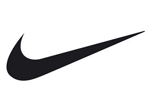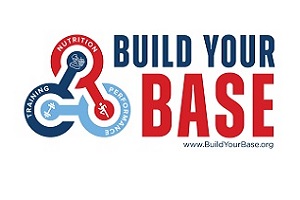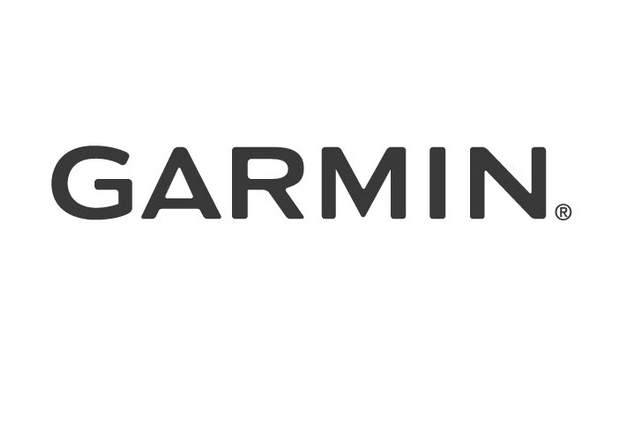Jim Spier’s Blog: World Youth Olympics in Nanjing, China (Aug. 31 FINAL update!)
Final Day: Trip to Suzhou with new friend Rachel
Photos by Joy Kamani (top to bottom, left to right): 1) street scene in Suzhou; 2) Rachel negotiating with a rickshaw driver; 3) a well-dressed romantic couple during a photo shoot on a scenic stroll; 4) one of many pagodas we saw; 5) a street vendor selling flower bracelets; 6) a canal in Suzhou lined with shops and residences; 7) part of our lunch in Suzhou; 8) a shop cat sleeping in a paper cutting store; 9) another couple during a photo shoot here, this time on a bridge over a canal; 10-11) yet another unusual t-shirt that we couldn't help getting on film.
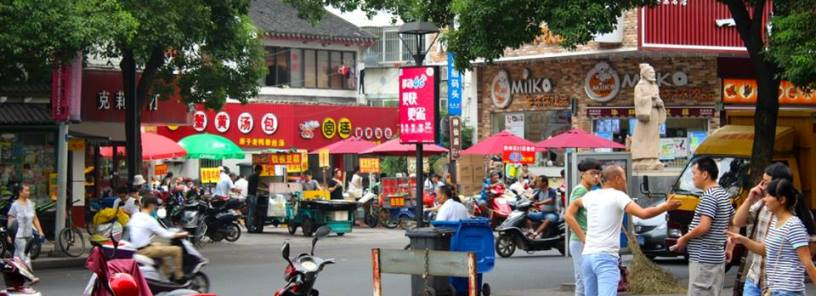
2014 Youth Olympic Games
The athletics competition ended with the last session Monday night (save for the 8x100m street relay on Tuesday). So ended our 7-mile walks each day – at least those that included multiple trips to the Olympic stadium.
The competition was good, with some things lacking from a media point of view: 1) no video interviews in the mixed zone; 2) no rotating photographers, so Joy never got on the infield; 3) no video monitor in the media work room; 4) no tables to work on in the media tribune over the finish line. These are all executed properly in all IAAF meets we have been to. Maybe it will get worked out for the next Youth Olympic Games in 2018 in Buenos Aires, Argentina.
Speaking of the 2018 games, they are scheduled for September 11-23. That will probably present a problem for some members of the U.S. team, given high school football and cross-country, and that all student-athletes will have started a new school year and have otherwise long finished their track seasons.
There is talk of a Pan American Youth Championships for the Area team to qualify, rather than using the three qualifying meets used this time (North and Central America area trials, Carifta Games, and South 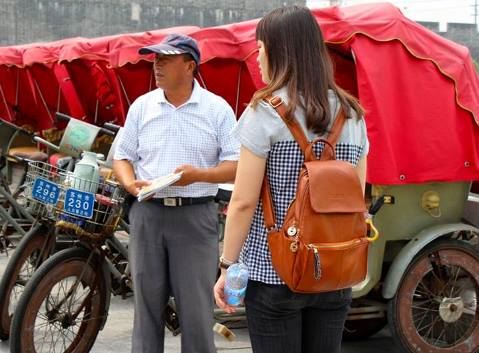 American trials). If that is the case, we hope that the trials would be held in late July or early August. That would eliminate some inherent issues: Athletes would more likely be “in shape” for a September competition; football players and those dedicated to cross-country would not even be at the trials.
American trials). If that is the case, we hope that the trials would be held in late July or early August. That would eliminate some inherent issues: Athletes would more likely be “in shape” for a September competition; football players and those dedicated to cross-country would not even be at the trials.
We’ll have a few years to determine all of this. Meanwhile, we were preparing for our Tuesday visit to Suzhou, the hometown of our 19-year-old volunteer friend Rachel. She had invited us a few days earlier to make this trip. We originally thought it would be a quaint Chinese village, but as we learned before we left, the quaint village is a city of 5,000,000-plus, one of 160 Chinese cities with population over 1,000,000 (http://en.wikipedia.org/wiki/Suzhou).
We all met at our subway stop at 7:30am on Tuesday morning and took the train about 8 stops to the railroad station. We went through security just to enter the station, similar to that of an airport.
We tried to give Rachel the train fare (about $16.00 for the 120-mile trip) for the four of us, but she told us that we each had to show our passports to buy the tickets. Apparently there has been a lot of counterfeiting of tickets, and this is the way the government avoids those kinds of problems.
So we got our tickets and found our way to the right track. It was a “bullet” train, and took just 1 hour and 20 minutes to get from Nanjing to Suzhou, even with five stops on the way. Another 20 minutes on this same train and we would have been in Shanghai.
The Suzhou train station is a magnificent modern structure situated on a giant, landscaped plaza. We were approached by rickshaw drivers to take us to the first stop, Shantang Street, a shopping area along a canal. They started at 50 yuan ($8) for groups of 2. We walked away and they chased us, the price eventually coming down to 30 yuan, but we decided to take a bus (2 yuan).
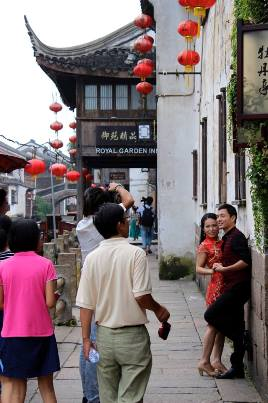
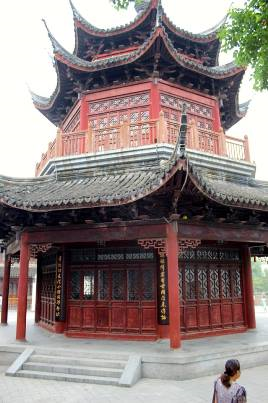
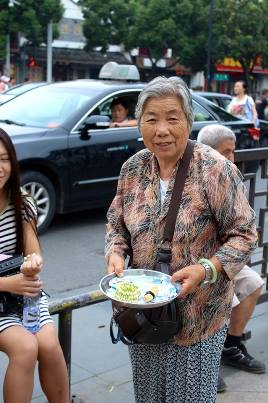
We took the bus to Shantang Street, a street on a scenic canal which used to be residential. Over the past dozen years, the houses have been transformed to restaurants and shops. We spent some time shopping, with SteveU and I leaving Joy and Rachel at one point (men and women view shopping differently, if you know what I mean).
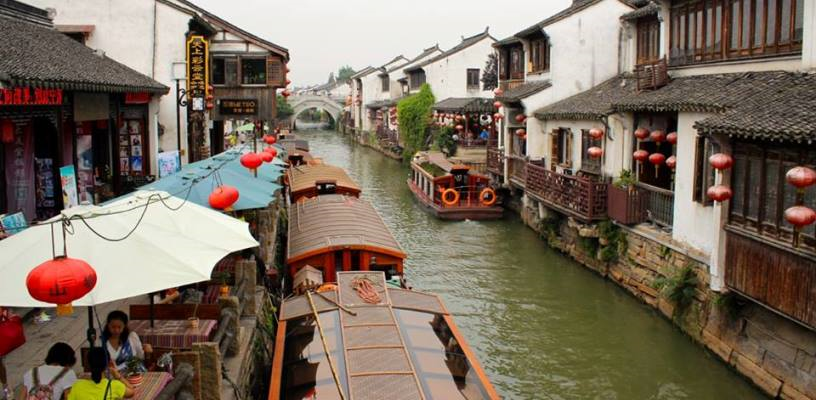
Steve and I reached the end of the street, looked over our left shoulder and there was a Starbucks. We took a break (it had a real American bathroom – including toilet paper!). We met up and Rachel took us to a traditional Chinese restaurant. We ordered our food and went upstairs to find a table. She ordered appetizers as well as our main course and, with drinks, the total was $15.00 for the four of us.
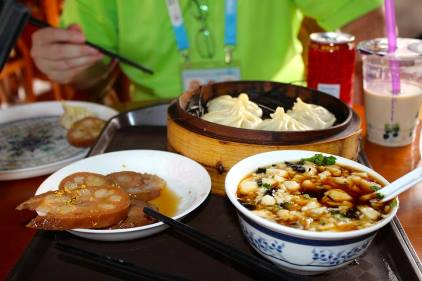
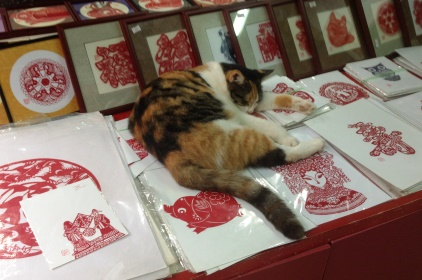
We wandered the streets thereafter before taking a bus to the Suzhou Museum, a structure designed by the Harvard educated I.M. Pei, a Suzhou native (http://en.wikipedia.org/wiki/I.M. Pei). It had magnificent displays, highlighting the long, rich history of the region.
We then took a taxi to another shopping street, Pingjiang Street. Then more shopping, capped off by a traditional dinner in a local restaurant. At about 7:15pm, we taxied back to the railway station and back home. I noted that the bullet train reached speeds of over 300km hour (186 mph) – I know because the speed is displayed in each car.
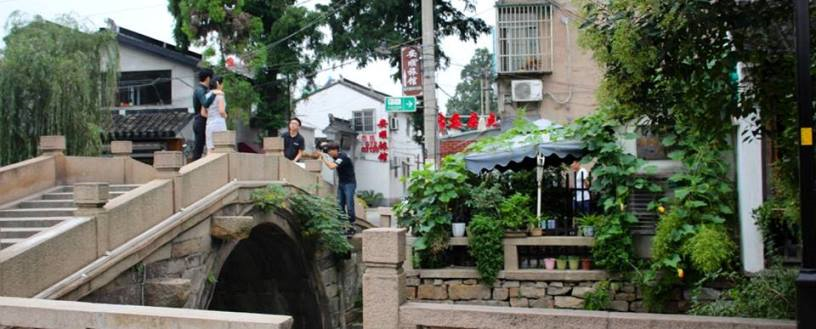
We returned to the hotel at about 10:30pm. I would guess that this was another high-mileage walking day even though we didn’t go to the stadium – probably in the 5 mile range.
Steve Underwood departed on Wednesday morning and would travel to Detroit after changing planes in Beijing. Joy and I would spend Wednesday night in Beijing and then returned to Houston on Thursday afternoon. I continued on to Charlotte, then Raleigh-Durham. I walked into my house at 1:00am Friday. Considering we had left the hotel in Beijing at noon on Thursday – midnight Thursday night EDT – it was a 25 hour trip for me.
Of course it was a very long trip both ways (literally going halfway around the world), but certainly worth the trip. The competition and cultural experience made this trip memorable, not only for us, but for the “kids” and staff on the team as well.
It will be interesting to see how Argentina compares. They are going through a financial crisis at the moment but I am sure they will be able to pull it off. They certainly have high standards to shoot for when it comes to matching the organizational skills of the Nanjing group and their 20,000 volunteers. But we are optimistic and look forward to the event.
Some final observations:
T-Shirts spotted:
- Happy Equestrianism
- Kindly Kitsch XOXO
- Acne (on the front; "I'm not saying I'm Batman, I'm just saying nobody has ever seen me and Batman in a room together" on the back!)
More food differences (our version vs. their version):
- Worcestershire Sauce vs. Well-Off Beef Sauce
- Balsamic Vinegar vs. The Balsamic Vinegar Sauce
- Water with lemon slices vs. Lemonade one day, Lemon Crush the next
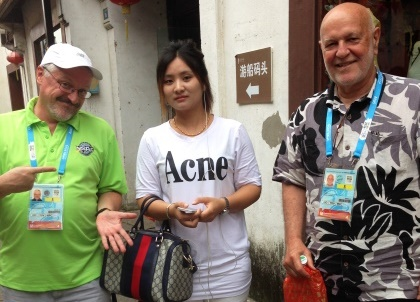
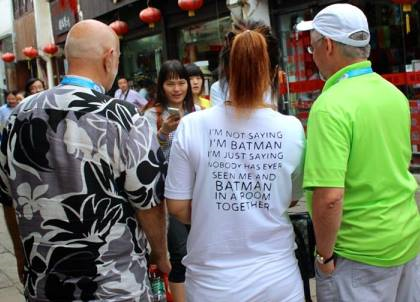
Days 6-8: A new friend (and translator)
Some observations:
- Nanjing is hot and sticky this time of year (like 90 degrees and 90 percent humidity). The natives say it’s cooler than normal.
- The subways are almost always crowded. That stands to reason since it moves a lot of people in this city of 8,000,000-plus.
- All entrances to the stadium (which are on the perimeter, over 100 meters from the stadium itself) have security checks. Everyone walks through the electronic sensor machine, and everyone also gets wanded. It is pretty amazing how fast the citizenry gets through these. There is never a line, even last Saturday night where there were 25,000+ fans.
With two-a-day sessions beginning on Saturday, our routine has become as follows: Leave hotel by 8:00am. Arrive by 9:00am for the first event. Observe the competition until 11:00am or so. Write the 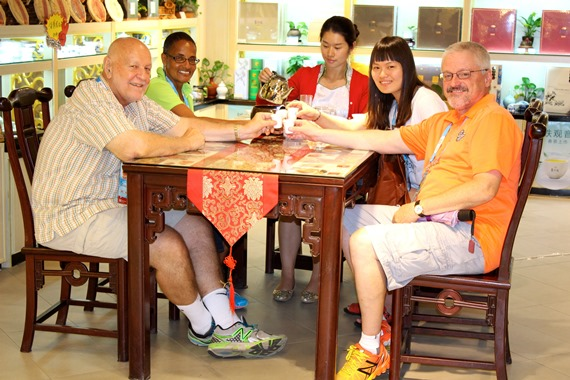 race in review summaries. Return to hotel at around 1:00pm. Return to track, leaving hotel at 6:00pm. Observe competition until 9:30pm. Write summaries until 11:00pm. Go to media meal room for “midnight snack” (Udon noodles, pizza, dumplings, French fries, fruit, ice cream).
race in review summaries. Return to hotel at around 1:00pm. Return to track, leaving hotel at 6:00pm. Observe competition until 9:30pm. Write summaries until 11:00pm. Go to media meal room for “midnight snack” (Udon noodles, pizza, dumplings, French fries, fruit, ice cream).
And, since the Metro stops running at 11:30pm, hail a taxi and return to the hotel. The midnight snack costs 5 yuan (80 cents). The taxi ride is between 30 and 40 yuan, or $5 to $6. The ride would be about $40 in New York City.
Continuing with the t-shirt observations, here are some new ones:
- 2014 World Cup: Germany fight Brazil
- X-Clever
And some expressions just a little different from ours:
Our expression / Their expression
- One per customer (meals in the media center) / One man, one meal
- Silence, please (notice at start of a race) / Please be quiet
On the ride in on Saturday morning, as I was getting off the train, a young girl, who looked about 19 or 20, approached me and starting speaking to me in English. That lasted for about 3 minutes until we parted at the entrance gate. As she said goodbye, she said that she was working at souvenirs concessions in the stadium.
I mentioned her to Steve and Joy and thought it might be interesting to get to know someone who appeared to be so fluent in English. So I tracked her down at the concession stand; she was excited to see me.
 We arranged to go to lunch on Sunday. We had observed a seafood restaurant near our hotel and thought it would be interesting to go there. It would certainly help to have a native speaker.
We arranged to go to lunch on Sunday. We had observed a seafood restaurant near our hotel and thought it would be interesting to go there. It would certainly help to have a native speaker.
So we met around noon on Sunday at the media center and headed for the subway (metro) and to the restaurant. We began to get to know her. She just completed her freshman year at a local university and wants to become an English teacher.
Her name is Jiang Zi Yun, but she goes by “Rachel.” We asked how she became to be known as Rachel. She said her English teacher in high school suggested that all the students have an English name. She was a fan of “that show with six friends,” she said. “Oh, you mean ‘Friends,” Steve said. Yes, and there was a girl on that show named Rachel, she liked that name, so that is now her English name.
We got to the restaurant. There were literally dozens of bins, all with running water with every variety of shellfish and fish imaginable. The idea is to select whatever you want and it will be cooked in the style you desire. Rachel helped us with that and we had a great seafood meal.
Rachel mentioned how beautiful her home town was, about an hour bullet-train ride from Nanjing. Since there is no competition on Tuesday (except for the 8x100m relay), and we didn’t return home until Wednesday, we suggested we go to her village. She said that she would check with her supervisor to see if that was possible (she is a volunteer, actually, so it’s not like she can get fired).
She also mentioned that there some English-speaking exchange students when she was in high school through last year. As a result, she picked up a lot of colloquialisms. She asked about the word “homey,” because that’s what the exchange students eventually called her. We explained the meaning to her, and decided that we would be her “homey.”
 After lunch, we agreed to have lunch again on Monday in a favorite, very typical restaurant of hers. She would also let us know about Tuesday travel. Steve mentioned that I had been pretty good at selecting different restaurants wherever we travel, and that I get it right 99 percent of the time.
After lunch, we agreed to have lunch again on Monday in a favorite, very typical restaurant of hers. She would also let us know about Tuesday travel. Steve mentioned that I had been pretty good at selecting different restaurants wherever we travel, and that I get it right 99 percent of the time.
Overnight, I got an e-mail from Rachel:
Dear My Homie:
My work partner told me I could have one day off on next Tuesday
I feel soooooooooo happy to accompany you to visit Suzhou.
Here is the bad news: my friend tells me the restaurant we decided to go to is just soso, not as good as before.
But I believe tomorrow you can guide us to another wonderful restaurant (99%!)
Have a nice dream – see u tomorrow.
This is quite exciting. On Monday morning Joy did some research on Rachel’s little village of Suzhou. It turns out that Suzhou is a city of 5,000,000-plus!! (http://en.wikipedia.org/wiki/Suzhou ). There are 160 cities in China with populations of !,000,000 or more!
We met again for lunch on Monday. This time we ate in the Chinese restaurant in the IOC hotel, where security clearance was required. Then we went to a Whole Foods-like store in the basement of a high end shopping mall, adjacent to the hotel, and had tea. Or, I should say, took part in a tea ceremony. It was done in the tea department by the tea saleslady and took about ½-hour. It was well worth it.
Finally, we decided to have ice cream on the Haagen Dazs store adjacent to the mall. Rachel was reluctant to go because she said it was very expensive. It was ($6.00 per scoop), but well worth it.
Tonight (Monday) was the final session on the track and we’ll likely have our 80-cent midnight snack at 11:00pm. Then a trip to Suzhou tomorrow to cap off our trip.
Day 5 - Exploring the "end of the line"
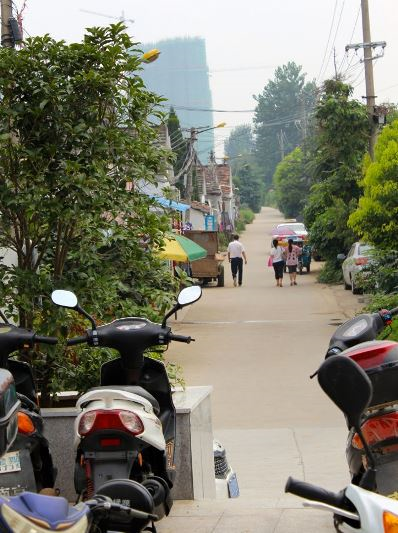 Friday morning, we decided to go the Olympic Sports Park where the BMX racing, beach volleyball, rugby and field hockey takes place. Like we do in other cities, we like to take one of the subway lines to the end. That would be the case here.
Friday morning, we decided to go the Olympic Sports Park where the BMX racing, beach volleyball, rugby and field hockey takes place. Like we do in other cities, we like to take one of the subway lines to the end. That would be the case here.
So we changed from the #2 to the #10 train and, after an hour and about 20 stops, we wound up at the end of the line. On the way, we couldn’t believe how spotless all of the subway stops were. .
I had miscalculated. The Olympic Sports Park was five stops prior. We took a walk outside and realized we were in the wrong place. The area was very much different than the main city of Nanjing – less hectic, and a bit more rural.
Prior to retracing our steps, I approached the six volunteers at the station. They pointed us in the right direction. They begged us to take their photo with us. Of course we did. There are 20,000 volunteers working these games, by the way.
We did make it to the subway stop at the Olympic Sports Park. We had to take the “J-4” bus to the park itself. It was another impressive complex. We had arrived between sessions, but at least we got to see it. We got on a bus that went directly downtown. From there we took a subway back to the hotel where we had lunch and rested prior to leaving for the evening session.
It was been a walking festival for us. For the last four days, we’ve walked 6 miles, 7 miles, 7 miles and 6 miles, respectively. Here is our routine: Leave hotel one hour prior to first event; walk one-half mile to subway; take subway 8 stops to the Olympic Stadium East Gate; walk one-half mile to staging area of golf carts; explain to the drivers (often requiring several attempts because of language barrier) where we want to go; they drive us to the stadium’s media center. That process takes about an hour.
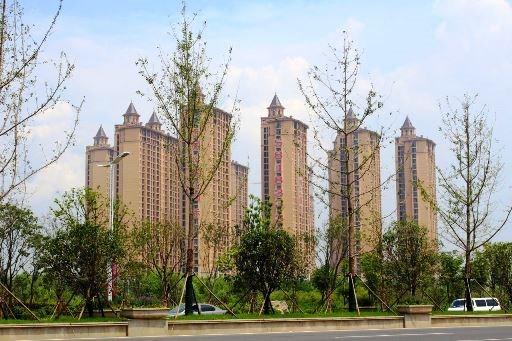 After each session, we retrace the steps. We could take the shuttle bus back to the hotel but it takes about 1 ½ hours and requires a transfer.
After each session, we retrace the steps. We could take the shuttle bus back to the hotel but it takes about 1 ½ hours and requires a transfer.
On Friday night, we decided to work after the meet (rather than back at the hotel), so we worked until 11pm, then ate the late media dinner provided (for 5 yuan – or about 80 cents). We got the midnight shuttle direct to our hotel (no transfer required in this case).
After a half hour on the shuttle I noticed that we were passing the stadium again. This shuttle went directly to our hotel, but stopped at six other hotels first. But it was only we three on the bus, all going to the Zhongshan Hotel. The driver stopped at those hotels anyway. I should say “passed” the hotels since he did not stop. We got to our hotel rooms at 1:10am. And awoke at 7:00am. Tomorrow night we will take a taxi.
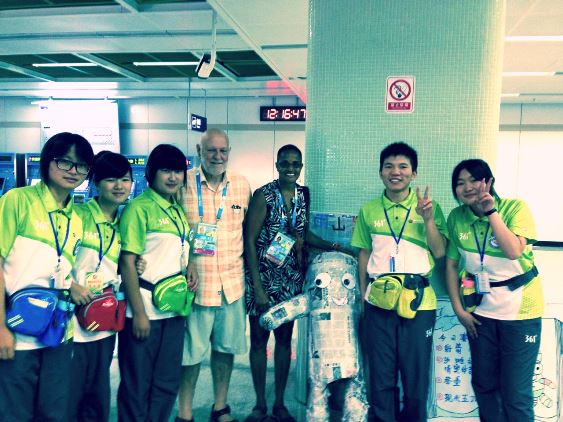 Chinese to English translation can be tricky. I have been keeping track of the names of some of the breakfast items which the hotel has labelled (the first column is the food; the second column is the translation):
Chinese to English translation can be tricky. I have been keeping track of the names of some of the breakfast items which the hotel has labelled (the first column is the food; the second column is the translation):
- Cherrios -- Crisp Circles
- Rice Krispies -- Rice Kris Pies
- Red Pepper -- Color Pepper
- Corn -- The Corn Kernel
- Red Cabbage -- The Red Cabbage
- Donut -- Circle Bread
Some observations about the populace: With all the people I have seen this week (a million ride the subways daily), only 2 males had earrings. And I have seen none with tattoos. The women dress well, but conservatively. They are extremely friendly and, if they speak even a smattering of English, randomly strike up a conversation with you. In the men’s toilet in the media center there are 3 urinals and 2 stalls. One of the stalls is just a hole in the floor, the other is an actual toilet. But no toilet paper in either (use your imagination).
I have been keeping track of the sayings on the t-shirts. They are either a direct translation from Chinese, or just a random group of words which are thought to be “cool.” Here is a sample:
- Sweet Addict
- Fresh Fish
- Softly, Comfortably
- Business 4 Dots
- Beating Hearts
- Pressing Voicemail
- Let Them Twerp
- Track and Jones
- Beautiful March Bravely, Yourself Less Attack
Day 4: Nanjing Museum, then some challenges at the track
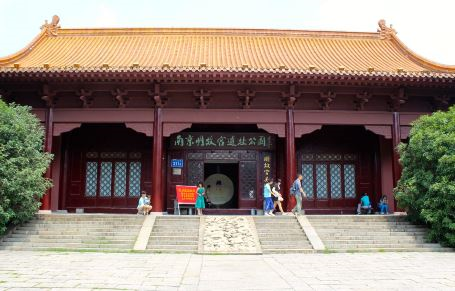 We’re getting into a routine now, though last night I stayed up until 1:00am finishing the meet’s summaries. The good news is that I got up at 8:30am, so it looks like I’m now accustomed to this time zone.
We’re getting into a routine now, though last night I stayed up until 1:00am finishing the meet’s summaries. The good news is that I got up at 8:30am, so it looks like I’m now accustomed to this time zone.
We walked to the nearby Nanjing Museum, rated among the top 3 in all of China. It was within walking distance of the hotel. On the way, we passed the ruins of the Ming Dynasty Palace. They really weren’t ruins as nothing was really remaining. It was mainly a park, but at least we can say we visited it.
On to the Nanjing Museum, a few blocks further. Admission is free, but one must show some kind of identification to get a ticket.
Our first stop was the Hall of Intangible Cultural Heritage. There are displayed samples of China’s folk art over the years, with some folk artists doing demonstrations – one of which is the art of paper cutting. There we observed Zhang Lin, a fifth-generation paper cutter. What she does is quite amazing. She demonstrated a simple pattern for us. What is really amazing is that she starts the design in the center of the paper which just a pair of (very sharp) scissors. We were really taken by her talent and her personality.
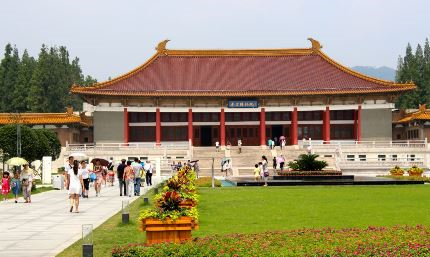
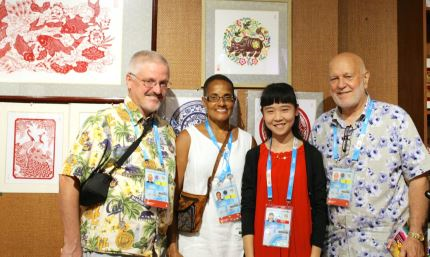
She received a degree in Business English from a local university and began paper cutting after that. She is probably in her late twenties. It took her only eight months (!) to learn the craft, she said.
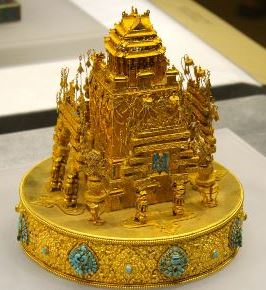
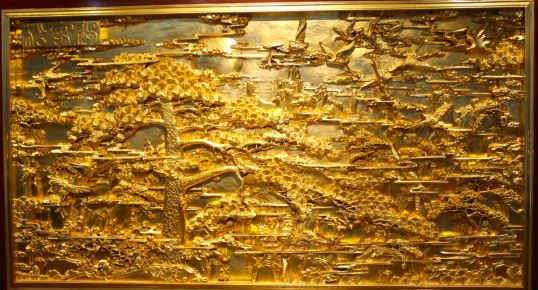
We continued on, marveling at the exhibits after watching a 20-minute 3-D introductory video. The three hours we spent there was nowhere near enough. We’ll have to come back again in a few days.
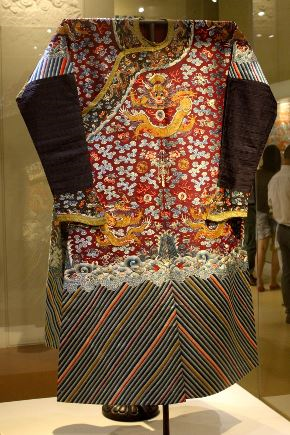
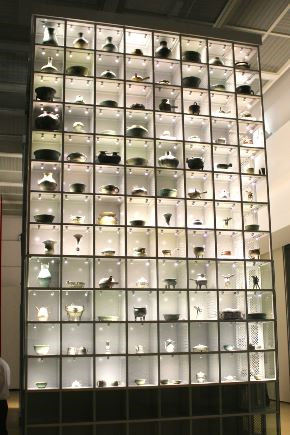
The meet began at 6:30pm. We noticed that the start lists were in stapled packets now, so that’s a good step forward. However, Steve Underwood, doing video interviews in the mixed zone, was told he could no longer do that. Yesterday it was fine. Today they enforced the rules. We went through a similar thing in last year’s Pan Am Junior Championships in Medellin, Colombia.
Steve contacted the local organizing committee and USATF, who would eventually contact the USOC. The LOC responded that video interviewing at the Olympic venues was not acceptable, unless you were a broadcasting rights holder. Let’s hope that we can get a positive response from the IOC.
It was not a good day for the Americans, who were competing in the qualifying rounds this evening. All finished in the bottom half of their events: Jeffrey Uzzell was 19th of 33 in the boys’ 100m, Janie O’Connor was 16th of 32 in the girls’ 100m, Kenneth Brinson was 14th of 15 in the hammer and Janae Moffitt was 14th of 16 in the high jump.
Tomorrow, two of “our” program kids are competing: Emma Fitzgerald in the javelin, and Chinne Okoronkwo in the triple jump. Their body clocks should be close to normal, and we wish for a good day for both of them.
We got out of the stadium at about 10:00pm and decided to take the shuttle bus back to the hotel rather than the subway. The bus takes longer (and requires a transfer), but it would beat the sardine-like conditions from last night’s subway ride.
We went to the stop outside the north gate but the normal routes for our C-4 or C-5 busses have been changed. They no longer stop there. So we walked to mile to the east gate to take the subway.
I hadn’t eaten for almost 8 hours, so was looking for almost anything at all to eat. Restaurants here close by 10:00pm, so the possibilities were not great. I noticed a Starbucks, KFC and Pizza Hut across the street. The KFC was open until 10:30pm, so I made it in just in time. It was not the cuisine I wanted, but it sufficed.
We took a late subway back and actually got a seat. We arrived at our stop at 11:30pm. The streets were now deserted, but there was a woman waiting outside the stop with a motor scooter. Her meet-volunteer daughter hopped on the back and off they went.
A major hospital is halfway between the subway stop and the hotel. As we passed, we noticed a man with his 80+ year old mother draped on his back jogging from the hospital to a waiting taxi. It was an alternative to a wheelchair, I suppose.
Friday will be the last day of evening-only sessions. We plan on taking the Metro to the Youth Olympic Park, the last stop on one of the subway lines, just to further explore the city.
Day 3 - Silk museum, then to the track
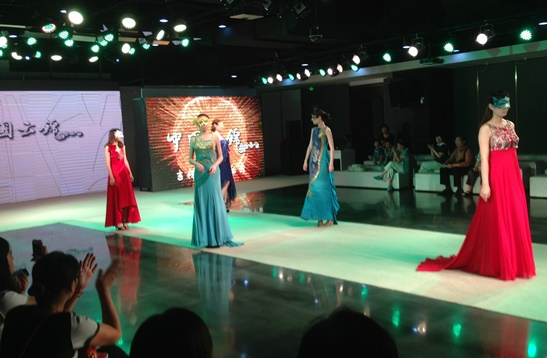 It was the usual breakfast to start the day at the hotel, but with some interesting food identifiers: “muffin cake” for a muffin, “bread circle” for donut, and “oil cake” for the same thing I had for dessert the night before, which was the “layer cake made with special pork oil.”
It was the usual breakfast to start the day at the hotel, but with some interesting food identifiers: “muffin cake” for a muffin, “bread circle” for donut, and “oil cake” for the same thing I had for dessert the night before, which was the “layer cake made with special pork oil.”
The meet would not start until 6:30pm, so we had another day to explore the city. We took the metro to the Nanjing Imperial Silk Manufacturing Museum. It is situated at the ruins of the Jiangning Imperial Silk Museum started 260 years ago.
There were old looms and old silk pieces and it was all quite fascinating. We even witnessed a “catwalk” show where young girls modeled silk dresses.
After the show, an English-speaking guide grabbed as and told her to join us as she gave a tour. It was in Chinese, but she amended her statements in English at each station. There were about 15 of us who started with her but, after about 20 minutes, the crowd dwindled down to just Joy and I. So we got the rest of the tour in English only.
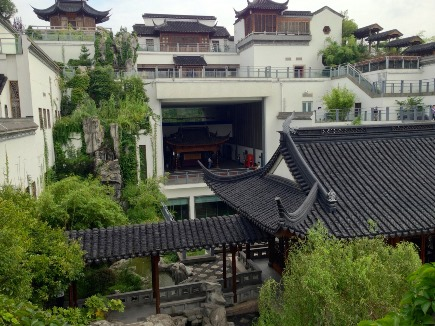
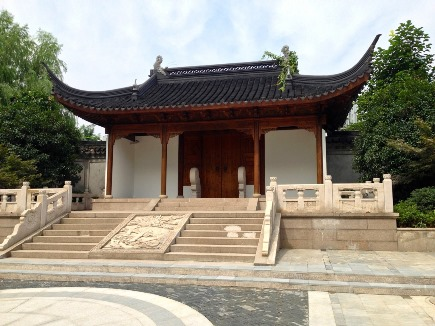
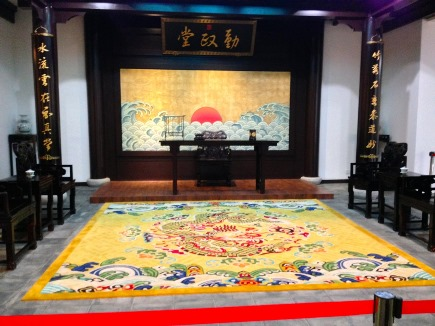
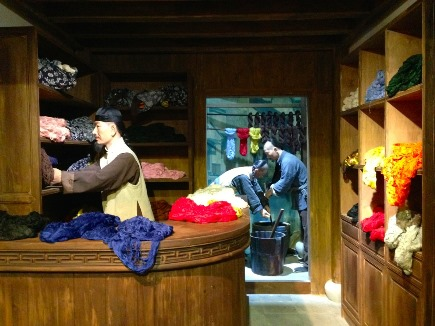
We got back on the metro and headed for the “Shigu Road Gourmet Street,” apparently the location of several international restaurants. It turned out to be an area not as “gourmet” as we are used to. Nonetheless we did have a decent Italian meal at a restaurant called “Ciao Italia.”
On the way back we passed an old woman on the street selling grapes and figs. We purchased four large figs for 10 yuan (or about $1.60).
We rested a bit at the hotel, then went off to the track by metro, arriving there at about 4:45pm for the 6:30pm start.
Joy has a pedometer and estimates that we walked six miles on Tuesday and seven miles today (Wednesday). Even though we take the subway, it is usually a significant distance from the subway stop to the destination. For example, to get to the Main Media Center at the Olympic Stadium from the Olympic Stadium East Gate subway stop is at least a half-mile.
The meet began and we estimate that there were about 15,000 people in the stands. That’s pretty good for an opening day, especially one where there no finals. We expect that the weekend will have significantly more fans.
Though the organizers are very efficient, there were some things absent from the usual international medial protocol. There were start lists for each event, but all together not in a stapled packet. The media tribune was simply a group of seats over the finish line, but they were just seats. In all other IAAF world championships that I have attended, there are tables in that area so a journalist can sit with his computer and write his story. And there were no monitors for individual event updates at each table. These were all lacking. Finally, the media workroom under the stadium had no television monitors so one could not tell what was going on at the track. And the media tribune was one floor above the media workroom, requiring an elevator ride.
For Steve Underwood, who usually lives in the mixed zone poised to interview athletes as they exit the track, he had to figure out how he could actually watch events and then get to the mixed zone to do interviews while still working in-between.
And Joy Kamani, who is photographing the meet, is not allowed on the infield. Normally there are “rotating” vests for photographers, meaning that a particular photographer can go out on the infield for a designated period of time after which he or she gives their vest to another photographer. There is nothing in place to have that happen. The only place Joy can go is on a platform in the stadium just beyond the finish line. And to get atop it requires a precarious climb. We understand these photographer issues are being addressed.
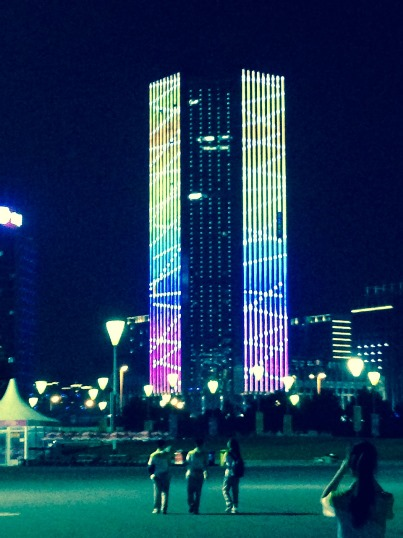
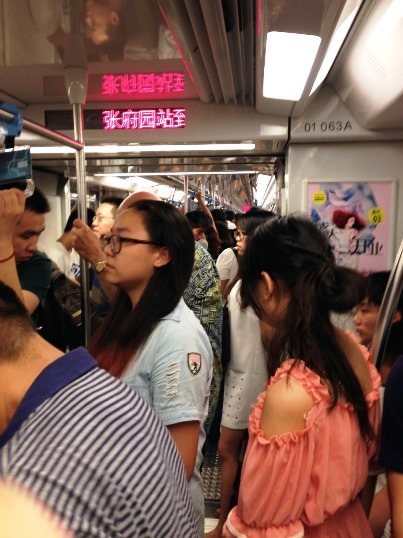
Day 2 - Long day of touring
(see previous entries -- Day 1-Orientation, Getting There - Part 1 & 2 -- below this one)
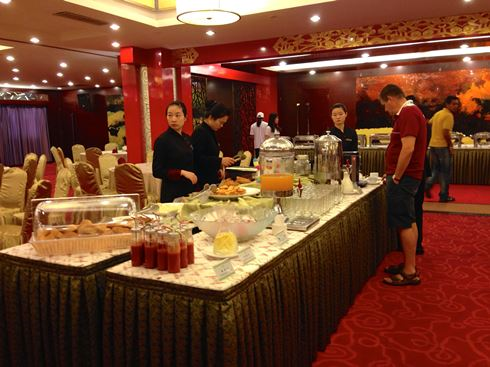 The day started with our first breakfast in the hotel, which was included in the price. There was nothing to complain about. There was cereal, eggs, fruit, coffee, tea and just about anything else one would find in an American breakfast buffet.
The day started with our first breakfast in the hotel, which was included in the price. There was nothing to complain about. There was cereal, eggs, fruit, coffee, tea and just about anything else one would find in an American breakfast buffet.
And of course, there was a large typical Chinese section. It included some kind of sausage, ulon noodles, rice, rice cakes, etc. And something called “At What Sausage Salad.” It was actually some kind of sausage salad. I’m not sure what the “At What” part meant.
Steve Underwood had arrived late last night and joined us for breakfast. It looked like he could use some sleep.
We finished breakfast and took Steve to the Olympic stadium to get his credential validated. We decided to take the subway rather than the shuttle bus. It turned out to take about half the time that the bus took, about 45 minutes. So I think we’ll opt for that mode of transportation from now on.
On the way to the subway, another credentialed journalist, also headed to the subway, asked if he could join us. Of course we said yes. His name is Maurice Gearlan, from Philippines TV. He is covering all Filipino athletes. We enjoyed being with him.
At the track, we noticed hurdle crew rehearsal taking place. There were ten hurdle cart pushers. When the 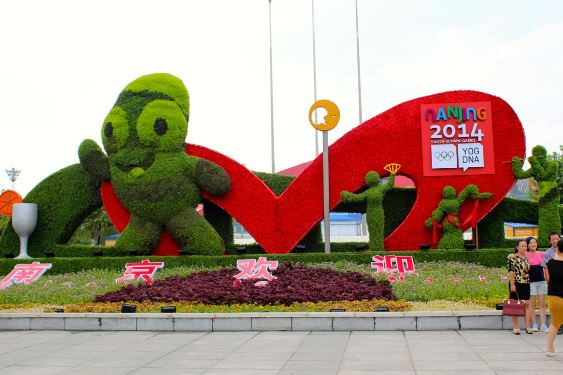 signal was given, they would push the cart of hurdles to their assigned hurdle mark. We saw two “takes”: running and pushing the cart, then putting the hurdles down at the assigned mark. The boss wasn’t too pleased with the timing from what we saw. I’m not sure how long they continued to rehearse.
signal was given, they would push the cart of hurdles to their assigned hurdle mark. We saw two “takes”: running and pushing the cart, then putting the hurdles down at the assigned mark. The boss wasn’t too pleased with the timing from what we saw. I’m not sure how long they continued to rehearse.
We decided to take in a bit of Chinese history (and look for lunch), so we headed to “Old Town,” the Fuzi Miao district. In this case, “old” means “really old” with the city having been established in 317 AD, right around where we were headed.
There saw typical Chinese architecture from hundreds of years ago, as well as plenty of traditional Chinese stores next to modern ones.
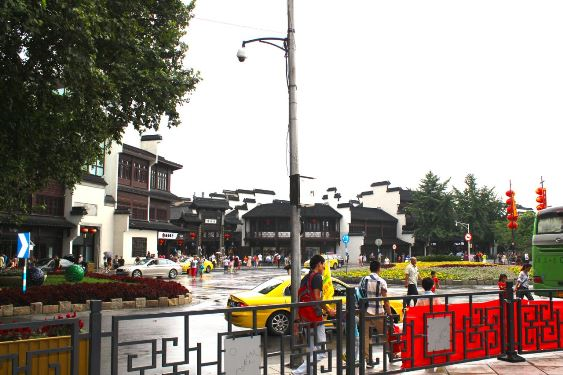 We searched for a restaurant but could not find one which had an English menu. We stumbled upon a cafeteria-like restaurant with about a dozen stalls. Each stall offered a different type of cuisine.
We searched for a restaurant but could not find one which had an English menu. We stumbled upon a cafeteria-like restaurant with about a dozen stalls. Each stall offered a different type of cuisine.
It worked like this: You purchase a debit card for 100 yuan (about $16.00) and select your food from the stall (or stalls) of your choice. The vendor deducts the food cost from the card and you continue until the money runs out. You can then purchase another card. Any unused funds on the card get refunded to you.
It worked really well. Joy went to the crawfish stall and the crab stall. I had some dumplings, some chicken wings and a large pork ball. Steve had food similar to mine.
One problem was that there was no soy sauce so the dumplings remained dry. And there were no napkins. One of the vendors saw me struggling and offered me some tissues. That helped. I saw a family at another table that brought their own roll of toilet paper which they used as napkins.
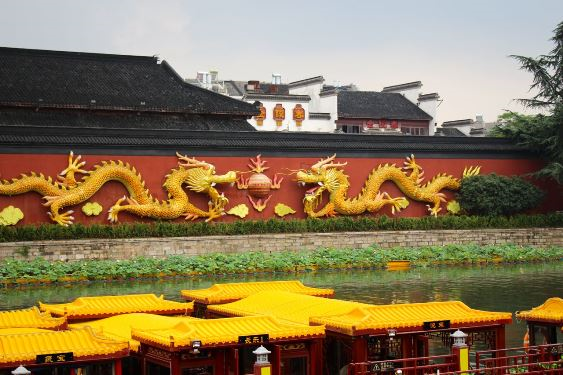 We took the subway back to the hotel. By this time it was rush hour, so the trains were pretty packed.
We took the subway back to the hotel. By this time it was rush hour, so the trains were pretty packed.
We met about two hours later in one of the hotel’s restaurants for dinner. We asked if there was an English menu and they said yes. In fact, it was an iPad with the menu in Chinese and English, along with photos of the dishes. Perfect!
It was a relatively large restaurant with almost no customers. There were seven waitresses so we became the center of attention. We were served by three waitresses along with their supervisor.
As I reviewed the menu, the young waitress stood next to me waiting for my order. It was a large menu so would take some time. She wouldn’t leave my side until I ordered. I thought about what I wanted, then gave the iPad to Joy. I tried to convey to her to return in five minutes until we decided, but she didn’t understand that. It took a while for both of us to make up our minds, but we finally ordered.
Joy ordered a pot of fish and some noodles. I had spare ribs and special fried rice. The fish was good, but very boney, which is sort of challenging to eat with chopsticks (though they did offer us a 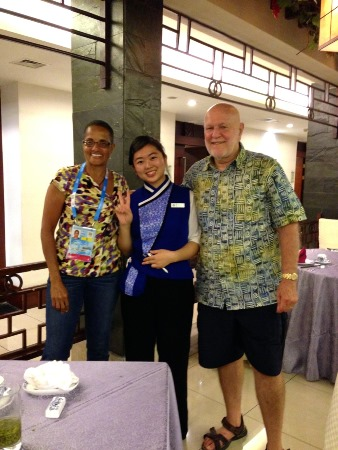 knife and fork). My ribs were good but nothing special. The fried rice was actually boiled rice with some scrambled egg inside.
knife and fork). My ribs were good but nothing special. The fried rice was actually boiled rice with some scrambled egg inside.
We ordered dessert. I had the special layer cake and Joy the chocolate cake. I might mention that Chinese sweets are not really sweet by Western standards. The layer cake was really like eating rubbery white bread baked, as the waitress said, “with special pork oil.” It also contained specks of candied lemon and candied turnip (yes, turnip!). The chocolate cake was OK, but not what we’re used to.
After requesting the check, we saw our two waitresses giggling and whispering. The braver of the two came up to us and said that the other girl would like to know if it would be OK if she could have her picture taken with the two of us. “Of course!” I said. She was ecstatic. We took the photo. It made her day! The other waitress requested the same and we complied.
Tomorrow the competition will start. The first three days (Wednesday, Thursday and Friday) would be evening sessions only, so we’ll get to see a bit more of the city during prior to those day’s sessions.
A bit more about Nanjing:
- It is a city of more than 8,000,000 people and encompasses 6,600 square meters. Most Americans are probably not even aware of its existence.
- It is a modern city, with a great transportation system (subway, bus, taxi). It is also very crowded.
- It was founded 317 AD.
- 300,000 Nanjing residents were murdered by invading Japanese soldiers in 1937, just prior to World War II. There is a monument in the city commemorating that fact.
-
Day 1 – Orientation
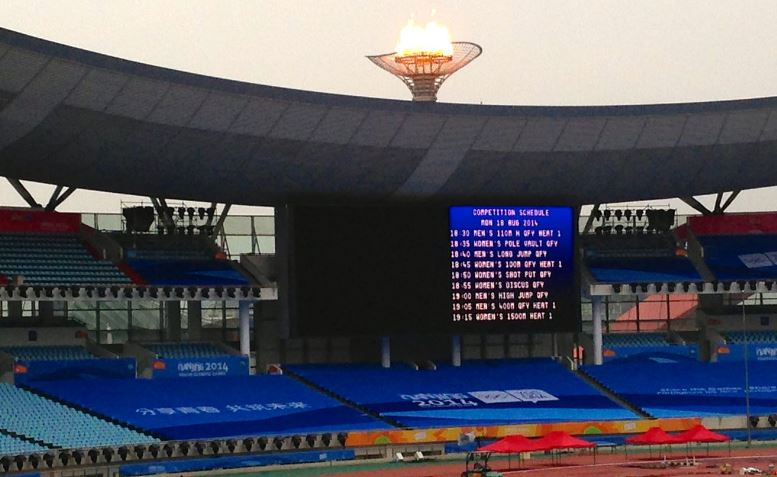
Joy Kamani photos (top to bottom): 1) The Olympic Flame inside the stadium; 2) a technical worker performs high above the stadium floor; 3) View of the track and stands; 4) as Jim describes it, a "septuagenarian flash mob" dancing in the streets in Nanjing.
Joy arrived a little before 3:00pm as I was concluding my walk around the hotel’s neighborhood. She got to her room, unpacked, and we took off for parts unknown at about 4:00pm.
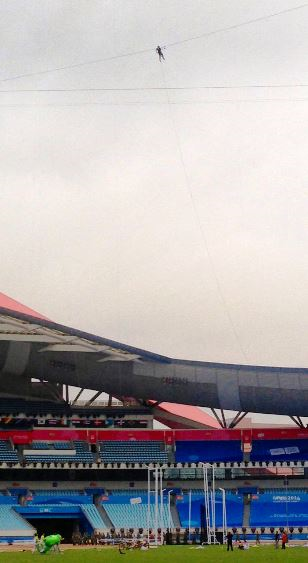 There are about nine dedicated bus routes servicing all of the hotels and the competition venues. We have a choice of two, the C4 and C5. In both cases, we would have to stop eight or nine times and change busses at the central bus transfer point, then take the C1 bus to the stadium.
There are about nine dedicated bus routes servicing all of the hotels and the competition venues. We have a choice of two, the C4 and C5. In both cases, we would have to stop eight or nine times and change busses at the central bus transfer point, then take the C1 bus to the stadium.
The trip passes by the equestrian, rowing and triathlon venues, among others. It is quite interesting to see the street life from the bus and orient oneself to the city, but the ride itself does take quite a bit of time – probably about an hour and a half from start to finish.
We finally arrived at the stadium. We had to have our credentials validated, which meant taking them to a separate building outside the stadium where the volunteers checked the credential against the passport one more time, then put a holographic sticker on the credential. Only then would we be able to enter the security checkpoint at the entrance to the stadium’s ground.
It’s pretty amazing in that you place your credential against a magnetic reader and your photo pops up on a large screen along with a green light meaning you’ve been approved.
The stadium grounds include the Olympic stadium (seating 60,000), as well as a natatorium and other athletic sites. We went first to the main media center, a very large room with seating for hundreds of journalists. One of the workers had the title, “Pigeonhole Supervisor.” She was obviously in charge of making sure results got place in the various pigeonhole files properly.
Then we walked to the main stadium itself. They were in the process of setting everything up, including all of television’s requirements. We walked in and saw a guy hanging from a wire connected to the north and south sides of the stadium, about 10 stories up. He was adjusting a place on the wire where the birds’ eye view television camera would be located. I couldn’t look up without getting sweaty palms.
Then we wandered around and found the media tribune and the media working area in the stadium. We were really hungry so decided to find a place to eat.
We got on the C1 bus and headed back to the transfer station and decided to get off one stop prior to find something to eat. We walked up and down the block and found a cafeteria. The problem was that there was no evidence that any English would be spoken.
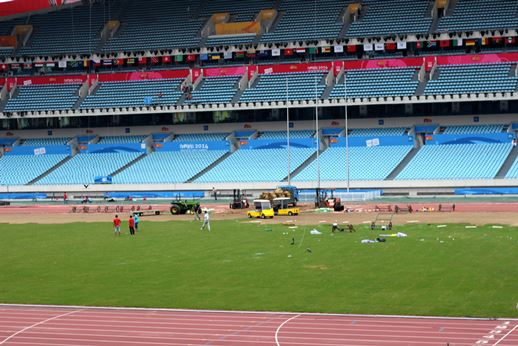 Joy and I looked at each other, our stomachs doing much of the deciding, and opted to give it a shot. How bad could it be?
Joy and I looked at each other, our stomachs doing much of the deciding, and opted to give it a shot. How bad could it be?
There were dozens of choices, with a server filling small plates of your choosing. We noticed some whole fish. Joy selected one, then noticed two other varieties.
“Do you speak English,” she asked.
“Yes,” he said.
“What kind of fish is that one?”
“It is fish,” he said.
“No, what KIND of fish?”
“Yes, fish”, he replied.
“OK, I’ll keep the one I have,” Joy said.
I chose a chicken leg, two varieties of dumplings, some chicken with broccoli and a half-liter of water. We each got a bowl of rice. The bill was 41 yuan, or about $6.00. We couldn’t believe it. And the food was quite good.
We wandered around and came upon a mall of sorts. Downstairs was a very large food court which went on for blocks. Some of the restaurants even had English menus. We noted that for future reference.
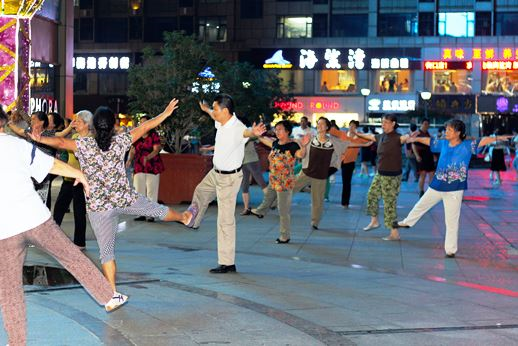 Outside the mall was kind of a septuagenarian flash mob, doing exercises to loud recorded music. There were probably about 200 of them.
Outside the mall was kind of a septuagenarian flash mob, doing exercises to loud recorded music. There were probably about 200 of them.
We went back to the bus stop and waited for a bus. The C4 bus stopped. I confirmed with the young volunteer that it went to our hotel, the Zhongshan. She said, “No Zhongshan hotel.” I tried pronouncing it as I thought it should be pronounced. “No Zhongshan hotel”.
Then I walked onto the bus and pointed to a map with one of the stops on the route. I said, “This Zhongshan hotel.” She said, “Oh! That Zhongshan hotel. Yes, this bus go Zhongshan hotel”.
We got on and could barely stay awake for the 45 minutes it took to get to our Nanjing “home.”
We got to the hotel at 9:30pm (9:30am Monday on the US east coast). We both crashed. I woke up at 4:30am and Joy at 7:30am.
We got an e-mail overnight from Steve Underwood stating that he had arrived in the hotel safely. His trip from Detroit had been without issues. In fact, he was accompanied by volunteers in Beijing and Nanjing to help negotiate all of the pitfalls we encountered.
There would be one more day of orientation before the meet begins tomorrow.
We noted that some World Junior champions are entered: Polish shot putter Konrad Borowiec and Jamaican hurdler Jaleel Hyde. Also entered is Polish female 100 meter finalist (11.42) from the World Juniors, Ana Swoboda. Though it’s been a long season, the meet promises to be a good one.
Getting There Part 2
We landed in Beijing at 4:15am, just ahead of the prior day’s cancelled flight.
So there were two Air China flight 996’s. The original one was renamed AC 9996, but many of the luggage tags still had the AC 996 flight number. So now you have 800 people with luggage with luggage tags saying AC 996 or AC 9996.
It was about one-half mile walk to customs. By now it’s 4:45am and we’re standing in long lines. As is customary in my experience in Asia and Europe, there are people trying to cut ahead of the line. But most were staved off.
We made it through customs, though there were some inquiries about the visas. Now for long walk to the subway which would take us to baggage claim. We arrived at baggage claim at 5:15am. We would to get our luggage, then recheck them to Nanjing.
The luggage started coming out at 5:30am. A half hour later there no luggage for Joy, me or a dozen other people. I went to the carousel where flight 9996’s was being disbursed. There as some luggage from our flight there but not ours. Then the carousel stopped.
Now it’s off to Air China’s lost luggage and another long line. And people trying to cut ahead. If they weren’t trying to cut ahead, they were going up to an agent and asking them questions (or yelling at them) while the agent was working with a customer.
Our time came, the agent looked in the computer (while being yelled at by someone else) and said that our bags went directly to Nanjing since we were part of the Youth Olympic Games. “Why didn’t anyone tell us that!!?” I thought to myself. We can only hope that that she told us was true.
Now we have to go to our Nanjing gate and another security checkpoint: computers out of the bag, no belts, no cellphones, and all that. I got frisked. Joy was told to follow the inspector to the supervisor’s stand.
They had found Joy’s meditation magnets (two two-inch long black oblong things) and wanted to know what they were and why she had them. She explained and they seemed to be pacified. (One would think a place like China would be aware of these kinds of things).
With that behind us, we can now go to the First Class lounge. It’s now 6:30am. My flight leaves at 8:50am and Joy’s at 11:00am. But the First Class lounge doesn’t open until 7:00am. So we go to the Air China business class lounge. I took advantage of a shower there and felt almost like a normal human.
We wandered down to the first class lounge at 7:00am. I stayed until 8:00am (my flight was to board at 8:50am). I got to the gate at 8:10am and the flight was already boarding. There was no announcement; passengers just stormed the gate and the agents took their tickets).
It was a two hour flight to Nanjing. The stewardess asked if I wanted a Chinese breakfast or a Western breakfast. I asked what was the Chinese breakfast. She said, “rice, and I don’t know names of other foods but Chinese breakfast is delicious.” Then she said, “I remember: rice and dumplings.” I told her I would take the Chinese breakfast. She asked what I wanted to drink. I said some kind of really typical Chinese tea. She said, “OK. I bring.”
I must say that the Chinese breakfast was not especially “delicious”. And the typical tea she brought was “Twining’s English Breakfast tea.” But all was pleasant nonetheless.
We landed in Nanjing. Now another half-mile walk to baggage claim. Just before entering baggage claim was a YOT desk with several teenage volunteers. Apparently there are thousands of them and they seem to be high school or college students with some degree of English language skills.
One girl rushed up to me. “I help you with luggage.” We went to the carousel and there was my bag, one of the first ones out. She said, “Come with me through security.” I did and was whisked through.
Just outside security was another table with the ground transportation assistants. They scanned my credential and said, “Oh. Hotel Zhongshan. This is not meet hotel.” I said, “Yes it is!” and pulled out my document proving that it was. “OK. Come with me.”
We walked another 500 meters to the staging area inside the terminal for the hotel buses. These were not shuttle buses, but large luxury buses dedicated to the YOT.
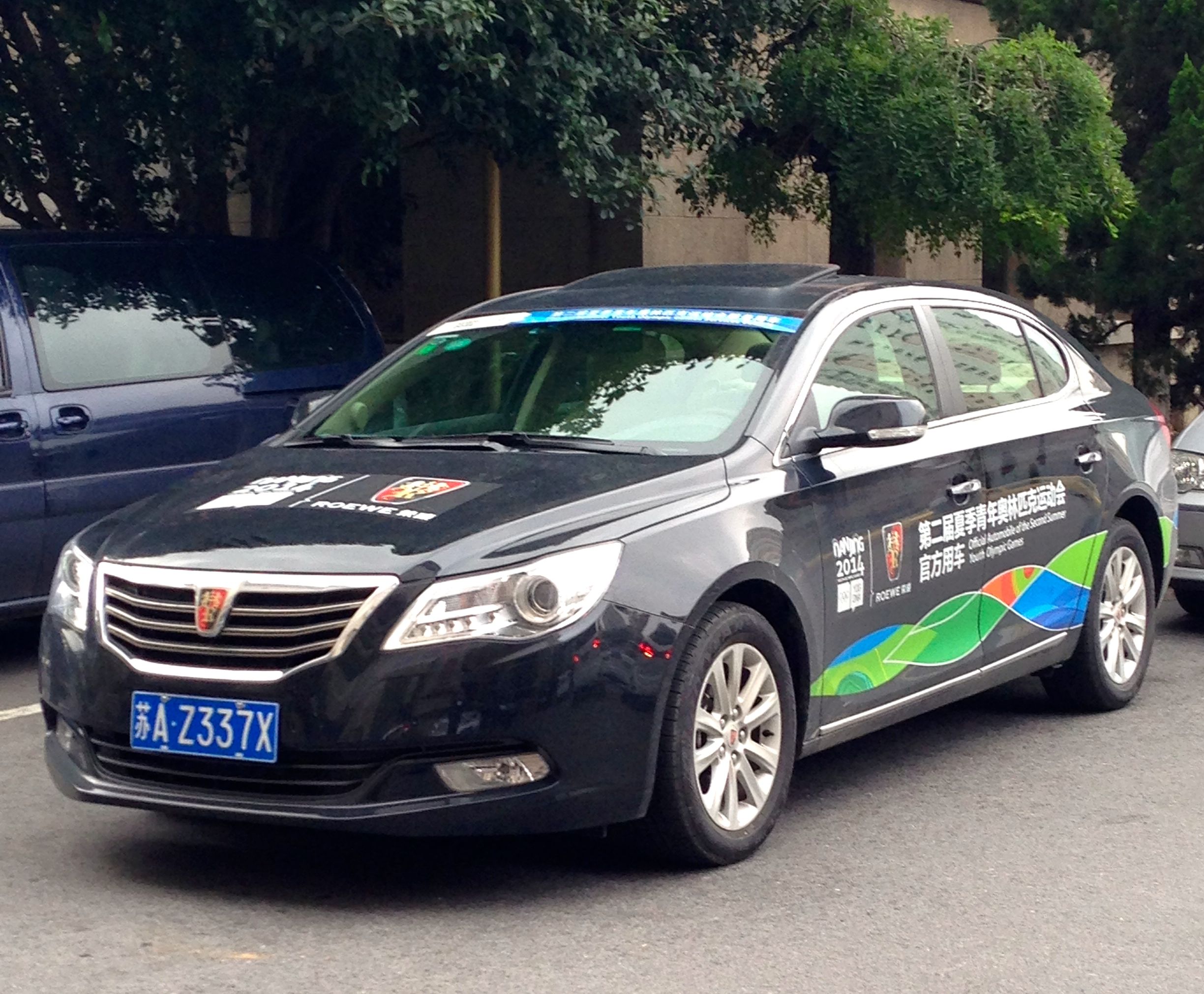
There was a desk and about 10 lanes set up, each lane having a flag which had the names of the three or four hotels that each bus serviced. Then there as about a 200 seat waiting area specially set up with televisions and refreshment.
I waited about a half hour and there was no bus. So I as assigned a driver in one of the hundreds of brand new cars dedicated for the event. I left the airport at about 12:15pm.
Nanjing is a major city of 8,000,000 people. It is modern and it almost looks like all the buildings are 10 years old or less.
We traveled on the Airport Highway. It would be about a 40 minute drive. There are light poles on either side about 40 meter apart. Every other light pole had two YOT banners, each about 2 feet by 5 feet. I calculated that there were about 2500 of these on each side of the highway for our drive. And this is just one highway. Everywhere you looked were posters, billboard, signs, all about the Youth Olympic Games. The city is really dressed up for this event.
For the first 20 mile of the trip on this 8-lane highway, there as about a car every 500 meters, so I was “smooth sailing” until we got closer to the city, at which point the highway narrowed and the traffic thickened.
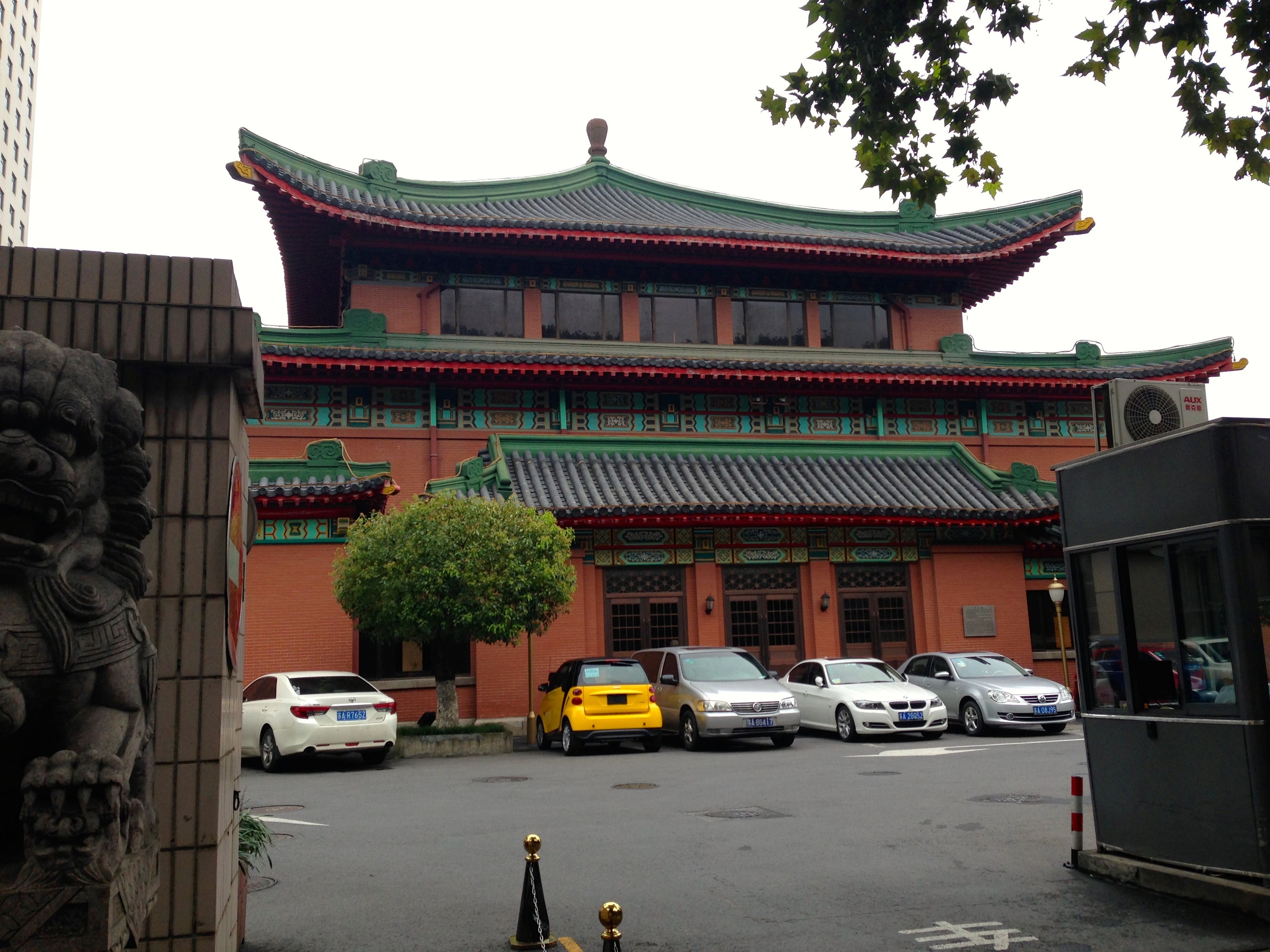
We finally got to the hotel at about 1:00pm. Fortunately, everything was in order t
here and I got my room. I did some basic research (like how to operate the TV’s remote control whose characters were totally Chinese). The TV has 120 channels, with about 8 in English.
There was on iron or ironing board in the room, so I called to request them. It was at my door seemingly as soon as I ended the call.
I took a shower, then walked a few blocks around the hotel area waiting for Joy. She would arrive a little before 3pm. Once she settled in, we would do some exploring.
For what it’s worth, here is the time line for my trip (all based on EDT). I think this give one an idea of how long a trip to Asia takes and of the inherent pitfalls:
Saturday:
9:30am Leave home for RDU airport
11:20am Depart RDU for Charlotte
12:15am Arrive Charlotte
2:20pm Depart Charlotte for Houston
4:30pm Arrive Houston
11:15pm Get on line at Air China checkin to get ticket
11:45pm Through security in Houston
Sunday:
1:10am Board flight to Beijing
2:15am Beijing flight takes off from Houston
4:15pm Flight lands in Beijing
5:15pm Clear customs in Beijing
5:30pm Arrive in Beijing baggage claim
6:15pm After no baggage, confirm with Air China that baggage will be in Nanjing
6:30pm Clear second security in Beijing
8:10pm Board flight to Nanjing
9:00pm Beijing flight takes off for Nanjing
10:30pm Flight lands in Nanjing
11:15pm Claim luggage
Monday:
12:15am Depart airport for hotel
1:00am Arrive hotel
So about 40 hours door to door!
Getting There- Part 1
It has been a busy year of traveling. We returned from Finland on August 8 and would leave for China about a week later.
I got an e-mail from Arione Allen on Wednesday, a friend and the person in charge of the Youth programs at USATF who had just begin the flight to China. She would be accompanying the 18 member team to the Youth Olympic Games and was confirming that we would be there.
On the team were two athletes from our triple jump and javelin programs, Chinne Okoronkwo and Emma Fitzgerald, respectively. I’ve gotten to know them both and they’re really great kids. I also heard from moms Patricia and Kikki, who had heard from their excited daughters. They were on their way in two group: Chinne with the west coast group and Emma with the Chicago group. They would all fly to Shanghai and take a bus to Nanjing, China, about a two hour drive.
Joy Kamani and I got our tickets to Nanjing (about a 2 hour flight from Beijing) last September (2013). We used our miles and decided to step and go first class. It was a few more miles, but would be worth it for the 14 hour flight.
On Thursday, Joy called Air China to request a special meal. They told her that her flight had been cancelled. What?? We were using Star Alliance points, administered by Air Canada for the Air China flights. I had made the original reservations and immediately called Air Canada. After a long wait, the agent said that they were in the process rerouting us through Tokyo and the only thing that was available was business class going and economy coming back.
I asked what happened to the flights. I was told they were cancelled. That was impossible, I thought. I checked the flights and they were still on schedule.
So I called Air China. They told me there was no cancellation. My flight was fine. Joy’s had been cancelled. I asked why and they said that Air Canada never confirmed it. That was odd because I had made the reservations at exactly the same time.
I then called Air Canada back. After a long wait, I told the agent to not reroute me and that Joy’s flight must be put back to its original state. After all, there were plenty of seats available. The agent said they would put an “urgent request” in with the scheduling department and we would hear back from them within four hours. It was now about 3:30pm.
At 6:00pm, I received a call from Air Canada saying that they were still working on it and someone would call me back that night or first thing on Friday morning. I asked what happened to Joy’s flight and she said that, somehow, the link between Air Canada and Air China had been “corrupted”. Not our problem, I thought.
I received no call on Friday morning so called Air Canada back at 10:00am. After a long wait, the agent said they would put in a second “urgent request” and, as such, an agent must call back within four hours.
Now I’m getting a bit nervous because the flight leaves in a day and a half. At 1:30pm, the agent called back and said that Joy’s flight had been put back in its original state, back in first class. I called Joy to break the news and she again began the process of her special food request. Meanwhile, I checked the new reservation on line, and she was indeed back on the flights, but in economy! Joy called Air China and the agent said that she was in first class, but they could not finalize the flight because they had not received the final authorization from Air Canada.
Joy spent as much time on the phone with Air Canada and Air China on Friday as I had on Thursday. Air Canada did a second “reissue” and this time got it right. So it all seemed to be sorted out and we would hope for the best.
Since our points were only good from Houston (Joy’s departure city) to Nanjing and back, I had to get to Houston. So I made a separate reservation, going from Raleigh-Durham to Charlotte to Houston. I leave at 9:30am on Saturday for my 11:20am flight to Charlotte. Even though the Beijing flight left at 1:00am on Sunday morning, I wanted to have options in case there were any delays along the way. But I arrived as scheduled at 4:30pm. I killed some time in the airport until I met Joy at a little after 10:00pm at the Air China ticket booth.
The place was mobbed. And the lines were not moving. As it turned out, the prior day’s flight from Beijing had been delayed – 23 hours worth of delay! So here 400+ people per flight trying to get their tickets or having them revalidated.
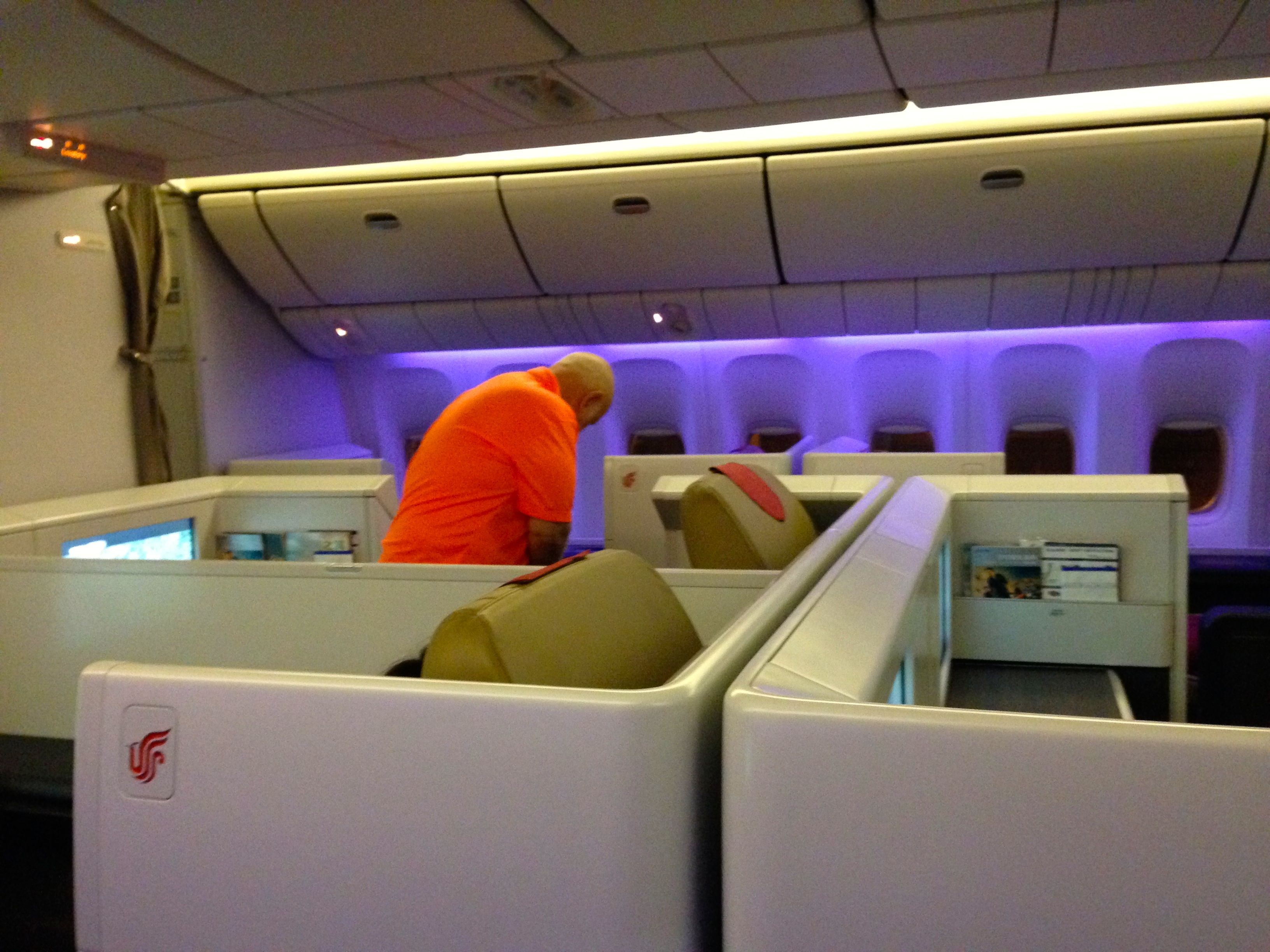
Joy and I held our breath as we approached the ticket agent. Anything could go wrong based on the prior 2 days activities. But it went smoothly. We had our credentials from the Youth Olympic Games and they served as our visas. With those, the agent on special blue tags on our bags, though she did not tell us the significance of them. Somehow it meant we would get some kind of special treatment once we got to Beijing because we were credentialed media for the Youth Olympic Games. We got though security at 11:00pm and went to the Air China lounge. We waited to board and got on at about 12:15am (now Sunday).
We went to the first class section. There were two rows of four pods, each a unique compartment with a seat that becomes a bed. If it were economy, there would be four rows of eight, or 32 seats.
The plane is huge. It’s a 777 and is configured for 400+ passengers. It is almost the length of a football field (250 feet). There were three of us in first class. And we had access to three bathrooms, so it would be a good trip. The stewardess (and there were 3 or 4 just for the three of us) gave me the menu and asked what I wanted. She said there would be two meals: one at 2:00am and one at 1:00pm. For the first time in my life I turned down a free meal. I wanted to get some sleep.
So the plane took off at 1:15am. I went to sleep at 2:00am and woke up at 10:00am. It’s a 14 ½ hour flight, so I only had only five hours to kill. I did that by watching two movies. I had been on several long hauls before: Seoul, Beijing and Sydney, and this one was a “piece of cake”.
During the flight, some of the pilots (there had to be four altogether) took advantage of the empty first class beds and rested. So I would look behind me and there would another strange face.
We landed a 4:15am. It was the smoothest landing ever (it seems like the bigger the plane, the smoother the landing).
Now the fun begins. Will there be any issue in getting through customs with our passport and the credential (which served as a visa)? Will our luggage be there? Will the transportation to the hotel work out? Will the hotel have our reservations? We have another 10 hours ahead of us until we know the answers to those questions.
